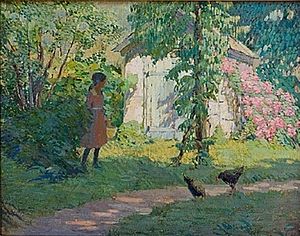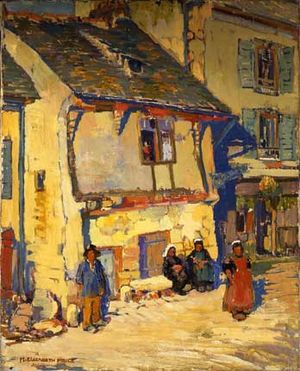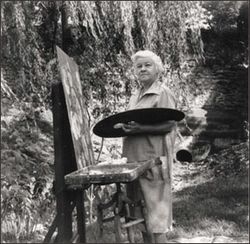Mary Elizabeth Price facts for kids
Quick facts for kids
M. Elizabeth Price
|
|
|---|---|
 |
|
| Born |
Mary Elizabeth Price
March 1, 1877 |
| Died | February 19, 1965 (aged 87) |
| Resting place | Solebury Friends Meeting House cemetery, Solebury, Pennsylvania |
| Nationality | American |
| Education |
|
| Known for | Gold leaf oil paintings |
| Awards | National Academy of Design 1927 Carnegie Prize |
Mary Elizabeth Price (born March 1, 1877 – died February 19, 1965) was an American artist. She was known as M. Elizabeth Price. She painted in the Impressionist style.
She was one of the first members of a group called the Philadelphia Ten. This group was made up of women artists. She helped organize many of their art shows. Her paintings were shown often at important places. These included the Pennsylvania Academy of the Fine Arts and the National Academy of Design. Many people in her family were also involved in art. Some were artists, others sold art, or made frames for paintings.
Contents
Early Life and Family
Mary Elizabeth Price was born in 1877 in Martinsburg, West Virginia. Her parents were Quakers. Their names were Reuben Moore and Caroline Cooper Paxson Price. Mary Elizabeth spent her childhood in Virginia and West Virginia. She then lived most of her childhood in Solebury Township. This area is north of New Hope. Her mother was born there.
Mary Elizabeth had a sister named Alice. She also had three brothers: Frederick Newlin, Rueben Moore, and Carroll Price. She graduated from the Friends' Central School.
Art Education
Price studied art from about 1896 to 1904. She went to the Pennsylvania Museum and School of Industrial Art. Then, from about 1904 to 1907, she studied at the Pennsylvania Academy of the Fine Arts. Her teachers there included Hugh Breckenridge and Daniel Garber. She also took private art lessons from William Langson Lathrop.
Art Career
In 1917, Price was in New York. She taught art to children at the Neighborhood Art School. This school was part of Greenwich House. A woman named Mrs. Harry Payne Whitney paid for the program. It taught children painting, drawing, pottery, and sculpting. In 1919-1920, Price showed the children's artwork. This was part of a plan to teach more people about art.
Unique Painting Style
Price is famous for her floral still life paintings. These paintings often used gold and silver leaf. She was inspired by painters from Siena and Florence during the Italian Renaissance.
She used a special method to create her art. First, she put red clay and gesso (a type of primer) on wooden panels. Then, she added metal leaf. After that, she painted figures or flowers with oil paints on top of the metal. This way, she made large, shiny panels. A critic from the New York Times said her work mixed "Sienese delicacy of line with a modern freedom in the use of color."
Some of her famous works include Mallows (1929) and Delphinium Pattern (around 1933). These were shown in a 2011 art show at the James A. Michener Art Museum. She also painted landscapes, everyday scenes, and ships. She made a special series of paintings about old Spanish treasure ships. One of her flower paintings, made around 1930, was of a Marsh Mallow. In 2011, it was valued at $40,000 to $60,000 on the PBS Antiques Roadshow.
In 1931, she created murals with Lucille Howard. Lucille Howard was also a member of the Philadelphia Ten. They made murals that looked like 18th and 19th-century needlework. These murals were for the American Woman's Association clubhouse in New York. Smith College owns one of her still life paintings of fruit. It was hung in Jordan House in 1922.
Art Exhibitions
Price showed her art in 1914 at the Pennsylvania Academy of the Fine Arts. She also exhibited at the Corcoran Gallery of Art in Washington, D.C. She continued to show her work at the Pennsylvania Academy almost every year until 1943.
Between 1921 and 1934, Price exhibited 16 times at the National Academy of Design. In 1927, she won the Carnegie Prize there. This award was for the best oil painting by an American artist. Her winning painting showed 16th-century Spanish galleons (large sailing ships). Her art was also part of the National Association of Women Painters and Sculptors' Fiftieth Anniversary Exhibition in 1939. She showed her work at many other places across the United States during her career.
Art Group Memberships
Price was an early member of the Philadelphia Ten. This group of women artists started in 1921. She helped organize shows and took part in many exhibitions. These shows were held in New York City, Philadelphia, and Washington, D.C.. Places included the Grand Central Art Galleries, the Whitney Museum of American Art, and the Corcoran Gallery of Art.
From 1920 to 1927, Price led the exhibition committee for the National Association of Women Painters and Sculptors. She organized 32 art shows across America. Some shows were even held in Buenos Aires and Rio de Janeiro.
She was also a member of many other art groups. These included the Pennsylvania Academy of Fine Arts fellowship, American Woman's Association, and the American Artists Professional League.
Life in New Hope, Pennsylvania
Mary Elizabeth Price lived in New York City for much of her early art career. In the late 1920s, she moved back to Bucks County. She settled in New Hope, Pennsylvania. She lived in an old yellow stone cottage called Pumpkin Seed. It was named for its small size and color. The cottage was next to a canal.
Price said, "When I first saw the original cottage it was painted such a vivid yellow that I instinctively thought of a pumpkin; and it was so small that I named it Pumpkin Seed more in derision than anything else. But the quaintness of the name grew on us so that we've learned to love it."
She grew a beautiful garden there. It had irises, mallows, peonies, lilies, and other flowers. She used these flowers as subjects for her paintings. She lived in Pumpkin Seed for the rest of her life. Her brother, who owned a farm nearby, also lived in the New Hope area. Price gave talks to the New Hope Women's Club. She showed her paintings and encouraged other local artists.
Death
Mary Elizabeth Price died on February 19, 1965. She passed away at Mercer Hospital in Trenton, New Jersey. She was 87 years old. At the time of her death, she was the last living of the Price children. She was a member of the Solebury Friends Meeting. She is buried in the Solebury Friends Meeting House cemetery.
Her papers and records are kept at the Smithsonian American Art Museum and the National Portrait Gallery Library.
Selected Artworks
- Bathing Along the Delaware River
- By the Laita, Quimperle, France, by 1921
- Bouquet
- Butterfly Weed No. 1, by 1929
- Cheerful Barge, oil on canvas, by 1929
- Delphinium and Black Pinks, by 1929
- Doorway to the Vineyard, Palazzo Afflitto, Italy, by 1921
- The Fountain, Ravello, Italy, by 1921
- Freight Boats, Menaggio, Italy, by 1921
- Gladioli and Japanese Iris
- House on the Hill, Quimperle, France, by 1921
- House of Jeanne, Quimperle, France, by 1921
- Ladies of the Villa d'Este
- Lavandieres, Quimperle, France, by 1921
- Market Day in Guingamp, France, by 1921
- The McGill Farm above New Hope, watercolor
- No. 1 Fuchsia, by 1929
- Picking Potatoes, oil on canvas, around 1933
- Sabot Market, Guingamp, France, by 1921
- Saint Aignan, Pig Market, France, by 1921
- Southern Magnolia
- Valley of the Delaware, oil on canvas
- Vase with White Poppies, James A Michener Museum, Doyleston, Pennsylvania
- A Villa on Lake Como, Italy, by 1921
- Village Queen, by 1929
- The Well Diggers, by 1929
- Wine Shop, Quimperle, France, by 1921, James A Michener Museum, Doyleston, Pennsylvania
- The Yacht Race




